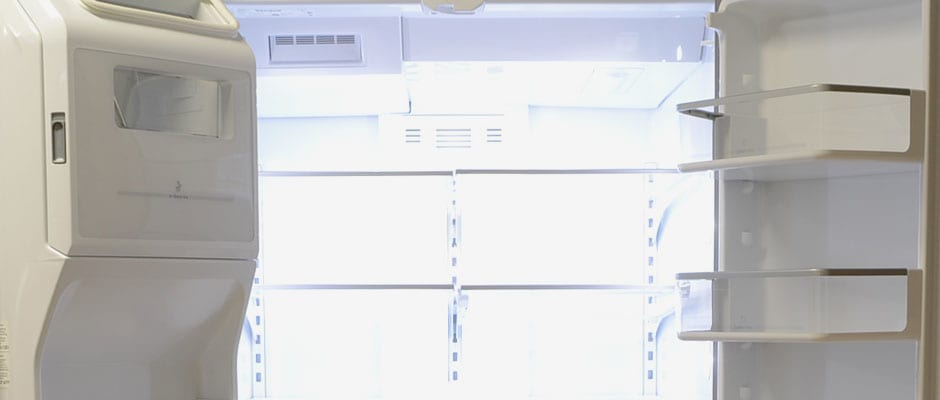Introduction
Best of all, it's affordable—at least as far as comparably-sized French door fridges are concerned. If you can find a sale, you'll be even better off.
Design & Usability
{{section_header}}{{section.name}}{{/section_header}}
Improved, but not reinvented.
This French door fridge has a stainless steel finish. On the left fridge door, you’ll find both the appliance’s control panel as well as a through-the-door ice and water dispenser.
With a large capacity—advertised at 29 cu. ft.—it's important that the inside sports more than just your average layout of shelves and drawers. Blue-tinted LED lighting gives food a clean, appetizing appearance. Also, it's worth mentioning that one of the adjustable shelves has a retractable portion for easy storage of tall items like flowers and wine—how romantic! To top it off, there are three drawers on the bottom instead of the usual two. Along with the regular dual crisper drawers, there's also a third, thinner drawer between them that's ideal for deli storage. Drawers in the fridge and freezer all slide quite smoothly.
At the very bottom of the fridge is a full-width drawer with its own independent temperature control. It has three settings, all of which are programmed in and cannot be altered. These are Meats / Poultry (32ºF), Cold Drinks (36ºF and the default setting), and Deli / Cheese (39ºF).
The pull-out freezer consists of three separate sections, plus an In-Door Pizza Storage compartment. It's essentially a thin opening in the door that's wide enough to fit two or three frozen pizzas when they’re placed on their sides. It’s a clever feature, and a necessary one: an average full-sized pizza would not fit in either freezer drawer since the dividers cannot be shifted enough to provide the necessary space.
{{ gallery "Design"}}
Features
{{section_header}}{{section.name}}{{/section_header}}
It doesn’t have a ton of spill protection, but this machine offers a familiar user experience.
The control panel utilizes symbols on a touch screen. They shine with a blue light when active, but turn off after the fridge is left alone for a minute or so. The touch-based controls are easy to read and very straightforward to use. Folks that prefer buttons to touch panels won’t be won over by this fridge, but it's sleek and intuitive.
The single paddle ice/water dispenser proved a bit too sensitive for our taste. Consumers with small children may want to use the control lock.
Speaking of spills, the shelves have some spill protection on the front and back edges, but nothing on the sides. You’ll want to be careful about where you keep liquids. The door shelves, however, are all quite well contained; if anything goes amiss there, it should be a cinch to clean.
Performance
{{section_header}}{{section.name}}{{/section_header}}
Great temperature control.
Up in the fridge, temperatures hardly shifted at all over time. Since fluctuations in temperature can affect food preservation, this was good news. We did notice that the temperature displayed on the control panel was a bit lower than the temperature we measured inside the fridge, though.
The freezer didn’t perform quite as well, but wasn't bad by any means. Again, our sensors read a bit warmer than what was on the control panel, so it couldn't hurt to turn the thermostat down a smidge here, too. Temperatures remained consistent over time and from top shelf to bottom shelf, and never went above 0ºF—so freezer burn shouldn't be a problem.
The only problem we had with this fridge was in the crisper drawers, which didn't retain as much moisture as we'd like to see. The WRF989SDAM wasn't bad, but other fridges in this price range do a better job.
Conclusion
{{section_header}}{{section.name}}{{/section_header}}
Solid performance, sleek design, and a decent price—what more could you want from a high-end fridge?
The $2,699 Whirlpool Gold WRF989SDAM is a fairly new addition to the Whirlpool family, and we’re quite pleased with how it turned out. With a sleek control panel, LED lighting, and sliding shelves, it's attractive and easy to use.
Overall performance was solid. We were impressed by the temperature consistency in both the fridge and freezer, though the crisper drawers weren't optimal. If you can find the WRF989SDAM on sale—minimal online searching turned up prices around $2,000—this Whirlpool should be on your shopping list if you're looking for a French door fridge.
Science Introduction
{{section_header}}{{section.name}}{{/section_header}}
The Whirlpool Gold WRF989SDAM performed very well in most tests, including fridge performance, freezer temperature consistency, and power loss. Unfortunately, the time it took to freeze items was a bit longer than average.
Temperature Performance
{{section_header}}{{section.name}}{{/section_header}}
Fantastic consistency, though things ran a little warm.
From the top of the fridge to the bottom, temperatures shifted about three degrees—about one-and-a-half degrees on either side of the middle shelf. It's also worth mentioning that even though we had the thermostat set to 37 degrees Fahrenheit, our test materials reached an average internal temperature of about 38 degrees. Temperature consistency of that kind is standard—in fact, it's better than many other models on the market. Fridges of this size tend to have a bit of fluctuation, which can be a good thing, since produce should be stored at a slightly warmer temperature than other refrigerated items. Add to that a minimal temperature fluctuation over time (less than a quarter of a degree) and you’ve got yourself an excellent fridge.
Issues in the freezer were essentially identical. For instance, the thermostat was set to zero degrees, but our sensors showed an average one-and-a-half degrees above that. It's not an issue, but we do prefer to see accurate temperature readouts. From top to bottom, there was a shift of just under five degrees, with fluctuation over time staying below a third of a degree. As long as you don't move things from one shelf to another on a regular basis, your food will be just fine.
{{photo_gallery "Science Section 1 Images"}}
Moisture Retention
{{section_header}}{{section.name}}{{/section_header}}
You can think of this as being on the good side of poor, or the poor side of average, whichever helps you sleep at night.
Over time, our test materials experienced an average loss of 0.18 grams of moisture per hour. We'd like to have seen it retain 0.03 to 0.05 grams more (which doesn't sound like a lot, but produce doesn't exactly have a lot of excess moisture to lose). Produce stored here should be fine for a few days, but anything more than that and you may start to notice a reduction in quality.
{{photo_gallery "Science Section 2 Images"}}
Freezing & Thawing
{{section_header}}{{section.name}}{{/section_header}}
No need to worry about frozen food thawing out, though it takes a bit longer than average to get there in the first place.
It took this Whirlpool about 1 hour and 40 minutes to bring our room temperature test materials down to a freezing temperature. This is a bit worse than average—long enough to compromise the texture of meats, fish, and other items. However, as long as you don’t plan on purchasing exorbitantly priced cuts of filet mignon and expect them to keep perfectly, you should be fine.
After 36 hours without power, the internal temperature of the Whirlpool’s freezer hadn’t even broken 28 degrees. This is excellent, though keep in mind we never open the freezer door while we conduct this test. If you’re stuck in a power outage (and have a reasonably competent electric company working to correct the situation), keep the door shut unless absolutely necessary and you won’t have to worry about throwing out a paycheck's worth of frozen food.
{{photo_gallery "Science Section 3 Images"}}
Storage Space & Energy Efficiency
{{section_header}}{{section.name}}{{/section_header}}
A respectable amount of space is paired with a respectable rate of energy consumption.
Moving the ice maker to the door and designing a slightly recessed water filter port may not seem like a lot, but every step taken to optimize space does add up in the end. In total, this Whirlpool's fridge provides 11.8 cubic feet of usable storage, a very respectable number indeed. The freezer, In-Door Pizza Storage and all, brings an extra 6.1 cubic feet to the party. While the fridge is on the large end of average, the freezer is definitely ample; bring on the holiday dinners, folks, you'll be able to feed the whole family with what you can fit in here.
This Whirlpool is not a cheap fridge to operate by any means, but it’s still highly efficient for a model of its size and capacity. Using a standard rate of $0.09 per kWh, we determined that it would cost $67.59 annually to operate. That's not exactly cheap, but keep in mind that this is a high-capacity fridge. For every cubic foot of usable space, this model requires only 0.11 kWh. That's actually very low; in fact, this figure definitively places it on the more efficient end of the spectrum.
{{photo_gallery "Science Section 4 Images"}}
Other Tests
{{section_header}}{{section.name}}{{/section_header}}
{{photo_gallery "Other Tests Images"}}
Meet the tester
Matthew is a native of Brockton, MA and a graduate of Northeastern, where he earned a degree in English and Theatre. He has also studied at the Gaiety School of Acting in Dublin and spends most of his free time pursuing a performance career in the greater Boston area.
Checking our work.
Our team is here to help you buy the best stuff and love what you own. Our writers, editors, and experts obsess over the products we cover to make sure you're confident and satisfied. Have a different opinion about something we recommend? Email us and we'll compare notes.
Shoot us an email


